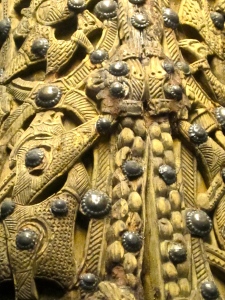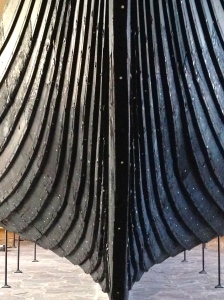
March 19, 2015. “What’s the best thing to see in Oslo?,” is the question I’m often asked by friends and family preparing for a visit. I know I’m a history geek, but I always recommend the Viking Ships Museum. Seriously, where else in the world can you go to feast your eyes on three incredibly intact Viking vessels? We all know about these Scandinavian raiders who pillaged most of Europe and were the first Europeans to touch foot on North American soil. (It’s now pretty much a proven fact — Columbus was late to the party.) So it’s a real goose-bump experience to see the vehicles that made it all possible.

But before we get into the tale of the Museum’s ship collection, here’s a little backstory for you: beginning in the late 1800s, archaeologists began excavating huge Viking burial mounds found on various farms throughout Norway (and Sweden and Denmark, too.) Yep, that’s right. Contrary to public perception, Vikings didn’t typically launch their chieftains out to sea in boats set ablaze via fiery arrows. This was a custom only infrequently practiced, usually by warriors who died on foreign soil and were being sent home on their “final voyage.”)\ Instead, homeland Vikings buried their revered dead with all the stuff they’d need for their long journey to the afterlife, then marked the gravesite with a big pile of earth and stones, just like the Egyptians. (Okay, on the west coast of Norway, sometimes mourners set the whole thing ablaze — ship, body, and grave goods — but that’s a story for another day and another archaeological site. )

Three of Norway’s burial mounds contained the most perfectly preserved Viking ships yet found, courtesy of tons of blue clay piled on top of them. Blue clay is anaerobic — no oxygen means no bacteria, and therefore little decay. On board were the dead, who rested on deck in a wooden replica of a tent, and tons of grave goods that included beds, musical instruments, sleds, carts, farm implements, tools for sewing and weaving, fishing and hunting gear, barrels of apples, wheat, beer, and much, much more. All of it amounts to incredible stuff that tells us about Viking daily life and reveals that, at heart, these folks were farmers and traders as much as they were sailors and raiders.

The Oseberg-farm Burial
When you enter the museum, your first sight is of the Oseberg ship, with its spiraling, serpent-headed prow towering above you. Long on style and short on seaworthiness, the shallow-sided ship was built as a karvi — a royal yacht meant for cruising along the coastlines of calm interior fjords. Writhing along the bow and stern are unbelievably intricate carvings of “grappling beasts” that twine together, gripping wrists, grabbing ankles, and generally trying to throttle one another. The design of the ship, its general state of wear, and dating of its oak timber tell us that it was built around 820 A.D. and used for about 14 years before being retired as the grave vessel for two women, one of whom was likely a high priestess of Freya, the Scandinavian goddess of love, fertility, beauty, and gold.


A nearby case holds the bodies of both the high priestess and her companion — perhaps a handmaiden, slave, or lesser priestess who volunteered to accompany her mistress into the afterworld. Various skeletal clues tell us that the high priestess herself probably had a pituitary tumor, which caused her to be rather dwarvenish in appearance: she was only five feet tall (fairly short for a Viking), with a stocky neck, unusually thick bones, and probably hairy to boot. Studies show she suffered from arthritis and osteoporosis and died of cancer at around 80 years old.
Her younger, slimmer companion could have been in her early fifties, and although she’d suffered a broken collarbone weeks earlier, the injury probably didn’t kill her. In fact, her bones reveal she was quite healthy, with no other indications as to the cause of her cause of death, beyond willingly choosing to be sacrificed as part of the funeral ritual (common in Viking culture.) DNA testing revealed that she came from Haplogroup U7, meaning she was descended from people who lived around the Black Sea, perhaps further evidence that she may have been a slave.
Grave robbers had denuded the ladies of their jewelry and discarded their elegantly robed skeletons in the thievery tunnel. Back in the original burial chamber (the wooden “tent” that rested on the Oseberg’s deck), rich textiles and finely wrought chests, combs, leather shoes, and other personal items proclaimed the women’s wealth. Household tools testifying to the ladies’ traditional feminine skills included several tapestries, looms, a pair of scissors, spindle whorls for spinning woolen thread, a yarn-winder, a sewing box, and a tablet loom still holding a partially completed ribbon.
Strange-looking metal rattles likely carried on cat-headed shafts, plus the cat carvings on the cart found in the bow of the boat, are what tell archeologists that the priestesses probably served the Viking fertility goddess Freya, who rode in a cart pulled by cats. Plus, encircling the ship were skeletons of a cat, four dogs, a bull and cow, a Eurasian Woodcock, a Red-breasted Merganser, and at least 15 horses (complete with bridles and a saddle). Also discovered on deck were three fancy horse-drawn sleighs, a working sled, two field tents, a wagon, five beds, and lots of kitchen utensils, including knives, buckets, dippers, bowls, lamps, a frying pan, a bread trough, and cauldrons that could be hung over a fire via a bird-footed tripod.

Perhaps my favorite kitchen item is the “Buddha Bucket,” (seen in the gallery above, bottom right) so-called for the cross-legged figures that fasten the handle to the rim. Despite their yoga poses, these colorful boys are enameled using traditional British techniques, which isn’t surprising considering that Dublin was the Vikings’ slave-trading capital. In fact, many Viking items feature intricate, interlocked designs resembling Celtic knots that show how the two cultures likely exchanged design ideas and influenced one another over time. And the seemingly Asian influence isn’t odd either, considering the Vikings had trading routes that connected them to the Far East.

The Gokstad-farm Burial
Like the Oseberg burial, the Gokstad burial contained a ship, but one built more sturdily and with a deeper hull for oceangoing voyages. Its steeper sides contained holes for 16 pairs of oars (meaning a crew of 32 men), plus wooden shutters that could be slid over the openings to prevent the vessel from taking on water when under sail. Racks along the ship’s railing allowed shields to hang along its outer sides, which not only encouraged tidy housekeeping but also advertised the arrival of fearsome Viking warriors to those about to be conquered onshore. The remains of 64 shields, painted alternately yellow and black, still hung in place at the time of the ship’s discovery.


A body of a local chieftain was also found on board in a wooden replica of a field tent. But like the Oseberg burial, grave robbers had divested him of his valuables (weapons), although his bones were allowed to remain in repose upon the burial bed. The burial chamber itself contained remnants of the dead man’s clothes, his fishing gear, and a game board with one antler gaming piece. Skeletons of 12 horses, eight dogs, falcons, and two peacocks surrounded the ship. And on its deck rested a sleigh, poles for a field tent, and three small but elegant boats built in a style still used today in many Norwegian villages.



During my niece’s visit, we went to hear a lecture by a gentleman who’d created full-scale, functioning replicas of two of the three ships in the Viking Ships Museum. He described how he’d built the reconstructions by hand using traditional Viking tools and explained that he was now working to raise money for the third boat — the Gokstad. His goal was to sail it around the entire coast of Scandinavia, tracing one of the ancient trading routes of his ancestors. At the end of his lecture, he invited us to come for a tour of the boats, which he keeps in a harbor about an hour south of Oslo. So guess what I’ll be doing when summer comes?

From this dedicated man I learned a fun tidbit about the ship. A group of Norwegians had built a replica back in 1893 and sailed it across the Atlantic, up the Hudson, through the Erie Canal, and into the Great Lakes to Chicago for the World’s Columbian Exposition. Funny that I’d never heard this story during all the years I’ve worked for the Museum of Science and Industry and The Field Museum, both of which can trace their origins to the 1893 World’s Fair. Apparently, the ship’s tip and tail still sit in MSI’s vaults, but its body now rests in Geneva, Illinois, where folks can tour it on weekends. Who would’ve thought I’d have to come all the way to Norway to learn this bit of Chicago history?
But if you want to see the original ship and its associated grave goods, come soon. Many of the items were preserved using alum and are decaying from the inside out. If researchers don’t find a solution quickly, it’s predicted that we may be the last generation to see such spectacular finds.

















The viking ship in Geneva IL is actually falling part– they are in the process of raising funds to renovate it, but I think they are looking for a new home. So if you have some land available for a replica viking ship museum…
LikeLike
Nova has a series on The Vikings, which the replay every so often. The segments on how they built these ships is amazing.
LikeLike